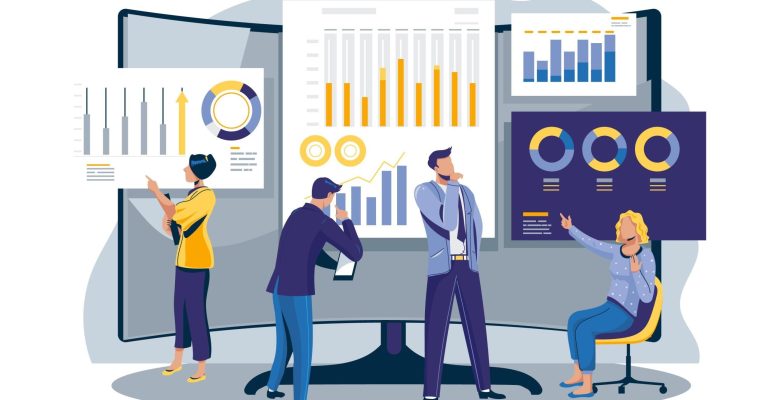Elevating Business Insights with Data Visualization in Salesforce:

Elevating Business Insights with Data Visualization in Salesforce:
In today’s data-driven world, businesses rely on comprehensive insights to make informed decisions and enhance their customer relationships. Salesforce, a leading Customer Relationship Management (CRM) platform, is not just about managing customer data; it’s a powerful tool for data visualization. Let’s dive into how Salesforce, combined with popular data visualization tools like Tableau and Power BI, Einstein Analytics, Zoho Analytics, and Klipfolio can take your business intelligence to the next level.
Salesforce and Data Visualization:
1. Data Visualization Capabilities:
Salesforce offers native data visualization capabilities through its reporting and dashboard features. Users can create customized reports and interactive dashboards to visualize key business data.
2. Real-time Insights:
Salesforce’s dashboards provide real-time insights into sales pipelines, customer service performance, and marketing campaigns. These visualizations help users track progress and identify trends at a glance.
3. Integration with Tableau:
Salesforce’s partnership with Tableau, a renowned data visualization tool, allows seamless integration. You can combine Salesforce data with Tableau’s advanced visualization capabilities for more sophisticated data representation.
4. Power BI Integration:
For those preferring Microsoft’s Power BI, Salesforce can be integrated with Power BI to create interactive reports and visualizations. This integration is ideal for organizations already invested in the Microsoft ecosystem.
5. Enhanced Decision-Making:
Data visualization in Salesforce empowers businesses to make data-driven decisions. Whether it’s monitoring sales performance, analyzing customer behavior, or tracking marketing ROI, visual data representation simplifies complex information.
Tableau and Salesforce: A Winning Combination
1. Tableau’s Strengths:
Tableau is known for its exceptional data visualization capabilities. By integrating Salesforce with Tableau, you can unlock Tableau’s full potential for creating captivating, interactive visuals.
2. Salesforce Data Integration:
Combining Salesforce data with Tableau allows you to create consolidated views of your customer interactions, sales data, and marketing metrics. Dive deep into your Salesforce data with Tableau’s drag-and-drop functionality.
3. Interactive Dashboards:
With Tableau, you can build interactive dashboards that enable users to explore data, drill down into specific details, and uncover insights effortlessly. This enhances your Salesforce experience and transforms data into actionable intelligence.
Power BI: A Microsoft-Approved Choice
1. Power BI Integration:
If your organization relies on Power BI, integrating it with Salesforce is a strategic move. It allows you to harness Power BI’s capabilities while leveraging your Salesforce data for business intelligence.
2. Microsoft Synergy:
The synergy between Power BI and Salesforce is particularly beneficial for organizations that use Microsoft solutions. This integration provides a seamless experience and ensures consistent data analysis across platforms.
3. Custom Reporting:
Create custom reports in Power BI that draw data from Salesforce. These reports can include visuals like charts, graphs, and maps, offering an in-depth view of your CRM data.
Einstein Analytics: Unlocking Advanced Insights
1. Einstein Analytics Strengths:
Salesforce’s Einstein Analytics is a powerful tool for data visualization. It offers AI-driven insights that go beyond basic reporting. With Einstein Analytics, businesses can identify trends, make predictions, and gain a deeper understanding of their data.
2. Native Integration:
One of the key advantages of Einstein Analytics is its seamless integration with Salesforce CRM. This integration enables users to combine CRM data with advanced analytics, providing a holistic view of customer interactions and business operations.
3. Predictive Analytics:
Einstein Analytics employs machine learning to provide predictive insights. It can help businesses forecast sales, customer behavior, and other key metrics, allowing for proactive decision-making.
Zoho Analytics: A Comprehensive Business Intelligence Solution
1. Zoho Analytics Features:
Zoho Analytics is a versatile data visualization and business intelligence tool. It offers features such as drag-and-drop report creation, interactive dashboards, and the ability to connect to a wide range of data sources.
2. Data Integration:
Zoho Analytics allows users to connect various data sources, including Salesforce, to create comprehensive reports and visualizations. This ensures that businesses have access to a wide range of data for analysis.
3. Collaboration and Sharing:
Zoho Analytics provides collaborative features, making it easy for teams to work together on data analysis. Additionally, it offers sharing options, allowing users to distribute reports and insights with stakeholders.
Klipfolio: Dashboard-Driven Insights
1. Klipfolio Dashboard Creation:
Klipfolio is known for its customizable dashboards. Users can create personalized dashboards that display key metrics, KPIs, and other relevant data points. This is ideal for businesses looking for a visual overview of their operations.
2. Data Connectivity:
Klipfolio can connect to various data sources, including Salesforce, to provide real-time data updates. This ensures that the information displayed on dashboards is always current.
3. Goal Tracking:
Klipfolio allows businesses to set goals and track progress. Users can create visual indicators that show whether specific targets are being met, making it a valuable tool for performance monitoring.
Conclusion:
Salesforce’s data visualization, combined with Tableau, Power BI, Einstein Analytics, Zoho Analytics, and Klipfolio, provides businesses with a comprehensive solution for advanced insights, seamless integration, and a competitive edge.

